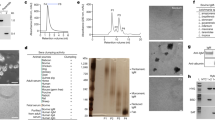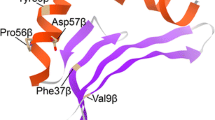Abstract
A series ofH-2 and non-H-2 congenic resistant (CR) strains on a C57BL/10Sn background were infected with 107 amastigotes ofLeishmania donovani. Non-H-2 congenic strains B10.LP-H-3 b and B10.CE(30NX) and (B10.LP-H-3 b × B10)F1 hybrids showed a very rapid decrease in liver-parasite burdens beyond day 21. Parasite counts for these strains at day 35 were significantly lower than for all other strains tested. The rapid decrease in parasite numbers, massive lymphocellular infiltration into the liver and strong delayed hypersensitivity reactions to parasite antigens in strains congenic for a portion of chromosome 2 indicated that acquired immunity toL. donovani was controlled by a dominant gene at or near theIr-2 locus. In addition, B10.129(10M) mice, which differ from C57BL/10Sn at theH-11 locus, showed highly significant increases in parasite numbers at day 35. Other observations supporting the absence of acquired immunity in B10.129(10M) included negative delayed hypersensitivity tests to parasite antigens and the absence of lymphocellular infiltrate into the liver. Although the differences were not as pronounced,H-2 CR strains withH-2 b,H-2 a, andH-2 k haplotypes also showed significantly greater decreases in parasite numbers by day 35 as compared to otherH-2 CR strains.
Similar content being viewed by others
References
Benacerraf, B. and Katz, D. H.: The nature and function of histocompatibility-linked immune response genes.In B. Benacerraf (ed.):Immunogenetics and Immunodeficiency, p. 117. Medical and Technical Publishing, London, 1975
Blackwell, J. M. Freeman, J. C., and Bradley, D. J.: Personal communication.Mouse News Letter 59: 56–57, 1978
Bradley, D. J.: Genetic control of natural resistance toLeishmania donovani.Nature 250: 353–354, 1974
Bradley, D. J.: Regulation ofLeishmania populations within the host. II. Genetic control of acute susceptibility of mice toLeishmania donovani infection.Clin. Exp. Immunol. 30: 130–140, 1977
Bradley, D. J. and Kirkley, J.: Regulation of Leishmania populations within the host. I. The variable course ofLeishmania donovani infections in mice.Clin Exp. Immunol. 30: 119–129, 1977
Bradley, D. J., Taylor, B. A., Blackwell, J., Evans, E. P., and Freeman, J.: Regulation ofLeishmania populations within the host. III. Mapping of the locus controlling susceptibility to visceral leishmaniasis in the mouse.Clin. Exp. Immunol. 37: 7–14, 1979
DeTolla, L. J., Semprevivo, L. H., Passmore, H. C., and Palczuk, N. C.:H-3 linked control of the immune response to leishmaniasis.Fed. Proc. 37: 1783, 1978
Gasser, D. L.: Genetic control of the immune response in mice. I. Segregation data and localization in the fifth linkage group of a gene affecting antibody production.J. Immunol. 103: 66–70, 1969
Gasser, D. L.:H-3 linked unresponsiveness toEa-1 andH-13 antigens.In D. H. Katz and B. Benacerraf (eds.):The Role of the Histocompatibility Complex in Immune Responses, pp. 289–295. Academic Press, New York, 1976 a
Gasser, D. L.: Genetic studies on theH-3 region of mice and implications for polymorphyism of histocompatibility loci.Immunogenetics 3: 271–276, 1976 b
Gasser, D. L. and Silvers, W. K.: Genetic determinants of immunological responsiveness.Adv. Immunol. 18: 1–66, 1974
Robinson, J. H. and Naysmith, J. D.: A comparison of four methods for measuring cutaneous delayed-type hypersensitivity reactions to protein antigens in the mouse.Scand. J. Immunol. 5: 299–304, 1976
Schacter, B., Pollard, K., Maylick, F., Humphrey, R. L., Hsu, S. H., and Bias, W. B.: T cell-specific human alloantisera-detecting antigens segregating outside the major histocompatibility complex.Transplantation 22: 604–611, 1976
Silver, D. M. and Lane, D. P.: Identification of the gene locus controlling dominant nonresponsiveness to F-antigen.Immunogenetics 4: 295–299, 1977
Stauber, L. A.: Host resistance to the Khartoum strain ofLeishmania donovani.In. Symposium on Resistance and Immunity in Parasitic Infections. Rice Inst. Pamphl. 45: 80–96, 1958
Stauber, L. A.: Characterization of strains ofLeishmania donovani.Exp. Parasitol. 18: 1–11, 1966
Taliaferro, W. H. and Stauber, L. A.: Immunology of protozoan infections.In T. Chen (ed.):Research in Protozoology, pp. 505–564, Pergamon Press, New York, 1968
Urba, W. J. and Hildemann, W. H.: H-2-linked recessiveIr gene regulation of high antibody responsiveness to TNP hapten conjugated to autogenous albumin.Immunogenetics 6: 433–445, 1978
Zaleski, M. B.: Preliminary evidence of genetic control of the immune response to the Thy-1.2 antigen in mice.Immunogenetics 2: 21–27, 1975
Author information
Authors and Affiliations
Rights and permissions
About this article
Cite this article
DeTolla, L.J., Semprevivo, L.H., Palczuk, N.C. et al. Genetic control of acquired resistance to visceral Leishmaniasis in mice. Immunogenetics 10, 353–361 (1980). https://doi.org/10.1007/BF01561585
Received:
Revised:
Issue Date:
DOI: https://doi.org/10.1007/BF01561585




